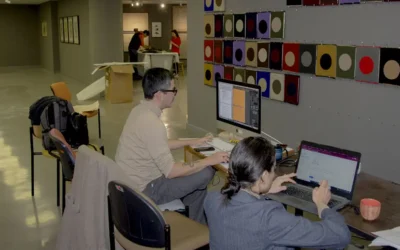TrendsWatch 2021: Digital Awakening

Rachael Cristine Woody
Every year the American Alliance of Museums (AAM) Center for the Future of Museums releases a TrendsWatch report. For the past two years I’ve written a response piece to each topic tackled within the reports. Continuing that strategy, this post addresses AAM’s second topic for 2021.
For an introduction to the TrendsWatch reports and the following miniseries, please see: TrendsWatch 2021: Navigating a Disrupted Future. The previous post in this series is TrendsWatch 2021: Closing the Gap.
The TrendsWatch 2021 report continues with the second of five topics: Digital Awakening: Essential technologies for pandemic survival and future success. While I find “awakening” to be an incorrect descriptor of a museum tool that’s been used for several decades, I can agree that the global pandemic has forced a re-evaluation and re-prioritization (a re-awakening, if you will) of how, when, and why we use digital tools. For the purposes of the report and this post, “digital tools” is being used to describe digitization, cataloging, and publication of collection materials online for audience engagement.
A Re-Emphasis on Putting Collections Online
This section begins with Elizabeth Merritt, Founding Director of the Center for the Future of Museums, acknowledging that the pandemic inspired a “frenzy” of “throwing content online”. Indeed, many libraries, archives, and museums (LAMs) found themselves in the startling position of trying to meet their mission to serve collections to audiences without physical access to their collections or their patrons. The shift to remote work meant a shift to collections work that could be done entirely online. Some LAMs were fortunate enough to already have a robust digital collections infrastructure in place while others were left scrambling to acquire digital tools and implement remote systems. And I think it’s fair to say that all LAM staff felt an urgency in the early pandemic days to not only meet user needs, but also provide cultural respite in what was the beginning of a very trying year. Merritt explains: “Digital engagement was a way for museums staff to help in the crisis, to apply their skills as a cadre of cultural first responders.”
I’ve Spoken About this Before
In my post LAMs are More Alike Than Different: Physical vs Digital Nature of the Work, I state the following:
Given that LAMs can reach more people virtually than they can physically—which is true even when it’s not a pandemic—I would like to see the scales tip from prioritizing funding from physical work to digital work. I would like to see LAMs invest more in digital collections and online engagement.
And I offer the following advice:
It’s time to assess your digital collections and reallocate resources (staff time and CMS money) to make sure you’re delivering the best virtual collection experience you can. Make sure your CMS is working hard for you, and make sure you’re using every tool and feature available to you to engage with your audience.
Content Creation = Revenue Generation?
While the shift to working on collections online was swift (all things considered), many LAMs were unable to crack how they could turn online content creation into a revenue stream. What’s not discussed here, but I think is implied, is that there isn’t an expectation that museums should charge for basic object access. However, all content created from the collections—online lectures, behind the scenes tours, curriculum units, educational happy hours, etc.—could and should be harnessed as revenue generating activities.
The Challenge: It’s Hard to Invest in Digital Tools When Money is an Issue
With this emphasis on online content generation and the possibility of turning it into a revenue stream, Merritt continues with the call to invest smartly into furthering a museum’s digital practice; arguing that doing so could help them rebound faster from the economic collapse that followed the pandemic. However, Merritt also acknowledges that investment in digital tools is difficult when the financial reality is that museums have less capital now than they did pre-pandemic. Additionally, they have an even smaller margin for error and a lower tolerance for risk. Merritt puts it best by stating: “The razor thin margins of the coming year will make decisions about digital adoption both more urgent and more fraught.” There’s a lot of pressure on museum staff to not just invest in digital tools, but to make sure they pick the *right* tools among a vast number of options.
Additional Challenges
But wait, there’s more. Merritt outlines these additional challenges:
- The public has a seemingly boundless appetite for videos, online courses, and online games, but museums can’t continue to feed content consumption without a corresponding financial plan.
- Museums need a longer-term strategy, one that incorporates a Return on Investment (ROI) for digital tools and staff time.
- Museums need to expand beyond a mere copying of what is physically displayed and begin to think of digital-first or even digital-only content experiences.
- Digital is often siloed into a department instead of integrated cross-departmentally as a tool, limiting vision and efficacy.
- Attracting and retaining skilled staff from the for-profit to the nonprofit sector.
- The perception that digital is an “add on” or “would be nice” feature that’s not necessary to the museum’s core mission.
- The lack of understanding and imagination among museums leadership as to what digital tools can do.
- We don’t know if the demand for digital content will remain once the risks of the pandemic wane, and people may rebound toward in-person and place-based experiences.
Recommendations
As this is an internal-facing topic, the recommendations are internal-only and this section.
- Integrate digital work into the everyday functions of the museum.
- Invite digital to have a seat at the museum leadership table.
- Assess needs of the museum and its audience and offer potential digital solutions.
- Offer training and education to staff and leadership so that the museum digital strategy is well-informed.
- Hire or partner with skilled people to implement new technology or lead digital initiatives.
- Apply digital strategy across all museum core functions and tie it to all (or most) elements of the strategic plan.
Resources
I have a few additional webinar resources to help you jump start your digital (re)awakening:
- Strategies for How to Capture and Communicate the Value of Collection Work
- Deriving Value from Collections in the Time of Corona (COVID-19)
I also invite you to check out Lucidea’s Think Clearly Blog and type “Museum Digital” into the search. There you will find several dozen posts authored by myself and fellow peers on how to harness the digital and online aspects of your museum collections.
Conclusion
As with the other topics in this report, this one comes with a full set of challenges. However, it is also the easiest area in which to achieve quick and impactful change that benefits your audience and the museum’s bottom line. Stay tuned next week for the next post in our series: TrendsWatch 2021: Who Gets Left Behind?

Rachael Cristine Woody
Expert, consultant and blogger Rachael Cristine Woody advises on museum strategies, collections management, digital museums, and grant writing for a wide variety of clients. She is a popular presenter and Lucidea Press author. For more on museum success, learn about Lucidea’s Argus Museum CMS for virtual, multimedia presentation of collections, visitor engagement, and museum staff productivity and impact
Similar Posts
How to Incorporate Interns in Museum CMS Projects: Data Creation
A museum expert details how interns can be successfully included in museum CMS projects at the data creation stage.
How to Incorporate Interns in Museum CMS Projects: Data Capture
A museum expert highlights how interns can be included in museum CMS projects at the data capture stage
How to Incorporate Interns in Museum CMS Projects
A museum expert highlights how interns can be included in museum CMS projects with three project ideas.
Create a Start-to-Finish Process for Cataloging Objects in the Museum CMS
A museum expert outlines the start-to-finish process for cataloging objects into a new museum CMS.
Hosting service
Enjoy all of the benefits of your Lucidea solution with secure, reliable, stress free hosting
Programs & incentives
No matter your size or budget, we’ve got you covered, today and tomorrow




Leave a Comment
Comments are reviewed and must adhere to our comments policy.
0 Comments